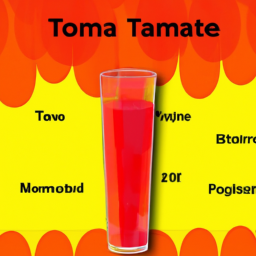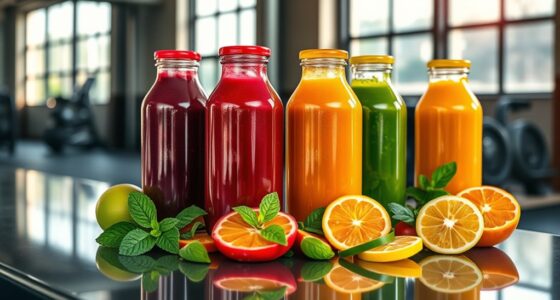As someone who loves making fresh juice, it can be frustrating when the juice goes bad quickly. It’s disheartening to throw out half a bottle of spoiled juice, especially after putting in effort and ingredients. That’s why I have spent time researching and experimenting with ways to make my homemade juice last longer.
In this article, I’ll share what I’ve learned about the spoilage process, choosing the right fruits and vegetables, preparing and storing your juice properly, using preservatives, vacuum sealing your juice, pasteurization techniques, monitoring juice freshness, and even reusing leftover pulp. With these tips, you’ll be able to enjoy your fresh juice for longer and waste less.
When it comes to fresh juice, it’s important to understand the spoilage process. Microorganisms like bacteria and fungi can start to grow in your juice as soon as it’s made, especially if it’s not stored properly. These microorganisms can cause spoilage, which can manifest as off flavors, odors, and even visible mold or yeast. The spoilage process can be accelerated by factors like temperature, exposure to light and air, and the pH of the juice.
By understanding the spoilage process, you can take steps to slow it down and make your fresh juice last longer.
Key Takeaways
- Properly preparing fresh juice with the right blending techniques and ingredient combinations can help extend its shelf life.
- Storing fresh juice in an airtight container and refrigerating it can prevent spoilage by delaying oxidation and exposure to air and light.
- Natural preservatives like lemon juice, honey, and ginger can be used to inhibit the growth of bacteria and fungi and prolong the shelf life of fresh juice.
- Freezing leftover pulp and reusing it can extend the life of juice and provide additional nutrients.
Understanding the Spoilage Process
You’re probably wondering why your fresh juice goes bad so quickly – well, let’s talk about the spoilage process and how to prevent it!
Understanding spoilage is crucial to keeping your fresh juice from going bad. The most common causes of spoilage are bacteria, yeast, and mold. These microorganisms thrive in warm and moist environments, making fresh juice a prime target for spoilage.
Preservation techniques can help extend the shelf life of your fresh juice. One of the most effective methods is pasteurization, which involves heating the juice to a high temperature to kill off any harmful microorganisms. Another method is adding preservatives, such as citric acid or ascorbic acid. However, these methods may alter the taste and nutritional value of the juice.
With this in mind, it’s important to choose the right fruits and vegetables to make your juice, as well as handle and store it properly.
Choosing the Right Fruits and Vegetables
When it comes to making fresh juice that lasts longer, choosing the right fruits and vegetables is crucial. Some produce may spoil faster than others, so it’s important to know which ones are best for juicing.
In addition to selecting the right produce, it’s also important to know how to pick ripe fruits and vegetables to ensure maximum juice yield and flavor.
Best Fruits and Vegetables for Longer Lasting Juice
To keep your juice fresh for longer, it’s important to choose the right fruits and vegetables.
I recommend opting for produce with a firmer texture like apples, carrots, and cucumbers. These ingredients have a lower water content which means they won’t oxidize as quickly and will keep your juice fresher for longer.
Additionally, consider the pairing recommendations for your juices. For example, carrots and apples are a great combination for a refreshing and nutrient-rich juice.
Juicing for maximum nutrient retention also involves using fresh, ripe produce. In the following section, I’ll share some tips on how to pick the best ingredients for your juice.
How to Pick Ripe Produce
It’s super important to choose the perfect produce when juicing, so don’t settle for anything less than the ripest, juiciest fruits and veggies. Proper handling and storage can help you get the most out of your produce.
Here are some tips for picking ripe produce and preserving freshness:
- Look for fruits and vegetables that are firm to the touch, with no soft or mushy spots.
- Check for vibrant colors and a fresh, clean smell.
- Avoid produce that has been bruised, damaged, or has signs of mold or spoilage.
By following these guidelines, you can ensure that your juice is made with the freshest, most nutritious produce possible.
Once you’ve selected your ingredients, it’s time to prepare your juice.
Preparing Your Juice
One key step for keeping your fresh juice from spoiling quickly is properly preparing it. This involves using the right blending techniques and ingredient combinations.
When blending your fruits and vegetables, it’s important to start with the softer ingredients first, such as leafy greens or berries, and then add the harder ingredients like carrots or apples. This will ensure that everything is blended evenly and there are no chunks or clumps in your juice.
In terms of ingredient combinations, it’s important to choose fruits and vegetables that complement each other in terms of taste and nutrition. For example, pairing sweet fruits like pineapple or mango with bitter greens like kale or spinach can create a well-balanced and flavorful juice. Additionally, adding a splash of lemon or lime juice can help preserve the freshness of your juice.
With these techniques in mind, you can create a delicious and long-lasting juice that will keep you feeling energized and healthy.
Now, let’s move on to the next step: storing your juice properly.
Storing Your Juice Properly
You want to savor every sip of your homemade juice and make sure it stays fresh, so let’s explore some effective ways to store it properly.
First, it’s important to note that the way you store your juice can affect its taste and nutritional value. One of the juice storage hacks to keep your juice from going bad quickly is to store it in an airtight container. Oxygen can cause oxidation, which can affect the color, taste, and nutrient content of the juice. Therefore, it’s best to minimize the amount of air that gets into the container of juice.
Another effective way to store your juice is to keep it refrigerated. Juices can become a breeding ground for bacteria when left at room temperature for too long. By keeping your juice in the fridge, you can prevent the growth of harmful bacteria and keep your juice fresh for a longer period.
Remember to place the airtight container of juice in the coldest part of your fridge, which is usually the back of the bottom shelf. With these simple juice storage hacks, you can extend the shelf life of your juice and enjoy it for a few more days.
As you explore ways to store your juice properly, you might also consider using preservatives to extend its shelf life even further.
Using Preservatives
If you’re looking to extend the shelf life of your homemade juice, try using preservatives to keep it from spoiling too quickly. There are two types of preservatives you can use: natural and artificial.
Natural preservatives are derived from plants, herbs, or spices, while artificial preservatives are synthesized in a lab. While natural preservatives may seem like the healthier option, they can be less effective than their artificial counterparts. Some natural preservatives, such as citric acid and vinegar, can alter the taste of your juice.
However, there are many natural preservatives that can be used effectively without affecting the taste, such as honey, salt, and lemon juice. It’s important to note that natural preservatives may not extend the shelf life of your juice as long as artificial preservatives can, so it’s important to use them in combination with other storage methods, such as refrigeration or freezing.
When using natural preservatives, it’s important to use them correctly to ensure they are effective. For example, honey should be added to the juice before bottling, while salt should be added to the bottle before the juice is poured in. It’s also important to use the correct amount of preservative, as too little may not be effective and too much may alter the taste of your juice.
In the end, the type and amount of preservative you use will depend on your personal preference and how long you want to extend the shelf life of your juice. To further extend the shelf life of your juice, vacuum sealing is another effective method. By removing all the air from the container, you can slow down the oxidation process that causes your juice to spoil.
Vacuum Sealing Your Juice
Sealing your juice in a vacuum is a great way to keep it fresh for longer. The benefits of vacuum sealing are numerous, including preventing oxidation and preserving the nutrients and taste of the juice.
When you vacuum seal your juice, you remove all the air from the container, which in turn removes any bacteria or mold that might be present. This helps to keep the juice fresh and safe to drink.
If you don’t have a vacuum sealer, there are other alternatives you can use to preserve your juice. One option is to use an airtight container and to fill it to the top to minimize the amount of air inside. Another option is to use a plastic wrap to cover the container and press it down tightly to remove any excess air. These methods can be effective, but they might not be as effective as vacuum sealing.
When it comes to making fresh juice last longer, vacuum sealing is just one option. Another option is to use pasteurization techniques, which involve heating the juice to a high temperature to kill any bacteria or mold present. However, this process can also affect the taste and nutrients of the juice, so it’s important to consider which technique is best for your needs.
Pasteurization Techniques
When it comes to extending the shelf life of your homemade juice, pasteurization techniques can be a viable option. One technique is high temperature pasteurization, which involves heating the juice to a high temperature for a certain amount of time to kill off any harmful bacteria. This method can significantly increase the shelf life of your juice, but it may also affect the taste and nutritional value of the juice.
Another technique is flash pasteurization, which involves heating the juice to a lower temperature for a shorter amount of time. This method can help preserve the taste and nutritional value of the juice while still ensuring that harmful bacteria are eliminated. However, it may not extend the shelf life of the juice as long as high temperature pasteurization. It’s important to consider the pros and cons of each method when deciding which pasteurization technique to use for your homemade juice.
As important as it is to extend the shelf life of your juice, it’s equally important to monitor its freshness. In the next section, we’ll discuss some tips for keeping track of how long your juice has been stored and when it’s time to discard it.
Monitoring Juice Freshness
To keep track of how long you’ve had your homemade juice and ensure it’s still safe to drink, it’s a good idea to mark the date of when you first stored it and regularly give it a sniff and taste test. Juice freshness monitoring is crucial in maintaining the quality and safety of your homemade juice.
Here are some freshness indicators that you can use to determine if your juice is still good to drink:
-
Color: Fresh juice should have a vibrant and consistent color. If the color has significantly changed or has become murky, it may be an indication that the juice has gone bad.
-
Texture: Fresh juice should be smooth and pulp-free. If you notice any change in texture, such as separation or pulp buildup, it may be a sign that the juice is no longer fresh.
-
Smell: Fresh juice should have a pleasant aroma. If you detect any sour or unpleasant odors, it may be an indication that the juice has gone bad.
-
Taste: Fresh juice should taste sweet and tangy. If the taste is flat or has a bitter aftertaste, it may be a sign that the juice is no longer fresh.
By regularly monitoring the freshness of your juice, you can ensure that you’re consuming a safe and nutrient-dense beverage.
Now, let’s talk about how to reuse leftover pulp.
Reusing Leftover Pulp
So, let’s recap what we’ve learned so far about making fresh juice last longer: we’ve talked about using the right storage containers, keeping the juice cold, and avoiding exposure to air and light.
But there’s one more thing you can do to get the most out of your fresh juice: reuse the leftover pulp! By incorporating the pulp into recipes like muffins, smoothies, or veggie burgers, you can extend the life of your juice and get even more nutrients out of your produce.
Give it a try and see what you think!
Recap of Key Points
Let’s review the main takeaways for keeping your fresh juice tasty and drinkable for longer. First off, it’s important to understand the benefits of fresh juice and how it can help improve your overall health. Incorporating fresh juice into your daily routine can provide you with essential vitamins, minerals, and antioxidants that support your immune system and increase energy levels.
When it comes to making fresh juice last longer, one of the most effective ways is to store it properly. Keeping the juice in an airtight container and refrigerating it immediately after juicing can help delay the process of oxidation, which leads to spoilage. Additionally, adding a few drops of lemon juice to the juice can help preserve its freshness and flavor.
By following these simple steps, you can enjoy your fresh juice for up to 72 hours.
Now, let’s move on to additional tips for making fresh juice last longer.
Additional Tips for Making Fresh Juice Last Longer
To further extend the shelf life of fresh juice, there are additional tips that you can consider. One of them is juice infusion, which simply means adding natural preservatives to your juice. Examples of these preservatives include lemon juice, honey, and ginger. These ingredients not only help prolong the shelf life of your juice, but they also enhance its flavor and nutritional value.
Lemon juice, for example, is rich in vitamin C, which acts as an antioxidant that prevents the growth of bacteria and fungi that can spoil the juice. Honey and ginger, on the other hand, contain antimicrobial properties that inhibit the growth of microorganisms in your juice.
Another tip that you can try is freezing your fresh juice. Freezing is one of the most effective ways to preserve the quality and freshness of your juice for a longer period. To freeze your juice, pour it into an airtight container or a freezer bag and store it in the freezer.
You can also use ice cube trays to freeze small portions of your juice, which you can later use for smoothies or other recipes. However, keep in mind that freezing can affect the texture and flavor of your juice, so it’s best to consume it within three to six months. Thaw the frozen juice in the refrigerator or at room temperature before drinking it.
Frequently Asked Questions
Can I freeze fresh juice to make it last longer?
Yes, freezing fresh juice is a good way to preserve its nutrients. However, it’s important to use airtight containers to prevent freezer burn. Personally, I’ve found that ice cube trays work well for portion control.
How long can I store fresh juice in the refrigerator before it becomes unsafe to drink?
Fresh juice can be stored in the refrigerator for up to 3-5 days before it becomes unsafe to drink. Proper juice storage techniques, such as using airtight containers and refrigerating immediately after juicing, can extend the shelf life of fresh juice.
Is it safe to drink juice that has been left out at room temperature for a few hours?
Drinking juice left at room temperature for a few hours is not safe due to bacterial growth. Proper juice storage is crucial to prevent contamination. Keep it refrigerated and consume within a few days for optimal safety.
Can I add additional fruits or vegetables to my juice after it has been prepared and stored?
Yes, I can add additional fruits or vegetables to juice after it’s prepared and stored. This allows for endless flavor combinations and the ability to tailor to my preferences. Adding ingredients may affect the shelf life, but that depends on the specific ingredients.
What is the best way to clean my juicer to prevent contamination and extend the life of my machine?
Maintaining my juicer is crucial to avoid contamination and extend its life. I use allusion in my cleaning tips to make it more interesting. I follow the manufacturer’s instructions, disassemble the parts, and clean them thoroughly with warm water and soap.
Conclusion
In conclusion, making fresh juice last longer requires careful consideration of various factors that influence spoilage. By choosing the right fruits and vegetables, preparing the juice properly, and storing it in the right conditions, you can extend its shelf life and enjoy it for longer. Additionally, using preservatives, vacuum sealing, and pasteurization can help preserve the juice’s freshness and flavor for an even longer period.
As with any culinary process, monitoring the freshness of your juice is crucial to avoid consuming spoiled or unsafe drinks. By paying attention to the color, texture, and smell of the juice, you can quickly identify any signs of spoilage and avoid the risks that come with consuming contaminated beverages.
Finally, don’t forget that the leftover pulp from your juicing process can also be reused in various recipes to minimize waste and make the most out of your ingredients. With these tips, you can enjoy delicious, healthy, and safely stored fresh juice for days to come.
Ilana has been a vegan for over 10 years. She originally made the switch for health reasons, but soon found herself becoming more and more passionate about the ethical and environmental implications of a vegan lifestyle. Ilana is the author of The Graceful Kitchen, a blog all about veganism. She loves to cook up delicious and nutritious vegan meals, and share her recipes with others who are interested in leading a cruelty-free life. Ilana is also a strong advocate for using whole foods as the foundation of a healthy diet, and believes that going vegan is one of the best ways to achieve this.










